Trailer towing (AWD models with towing package)
Your vehicle is designed primarily as a passenger-and-load carrying vehicle.
Towing a trailer will have an adverse effect on handling, performance, braking, durability, and fuel consumption. For your safety and the safety of others, do not overload the vehicle or trailer.
To tow a trailer safely, use extreme care and drive the vehicle in accordance with the trailer's characteristics and operating conditions.
The vehicle stability and braking performance are affected by trailer stability, brake setting and performance, and the hitch.
Lexus warranties do not apply to damage or malfunction caused by towing a trailer for commercial purposes.
Contact your Lexus dealer for further information about additional requirements such as a towing kit etc.
Weight limits
Confirm that the gross trailer weight, gross vehicle weight, gross axle weight and trailer tongue load are all within the limits.
The gross trailer weight must never exceed the following: 3500lb. (1588kg).
The gross combined weight must never exceed the following: 9480lb. (4297kg).
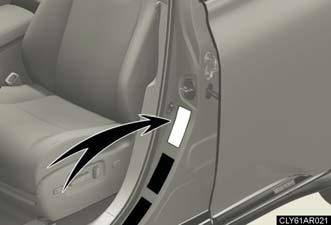
The gross vehicle weight must never exceed the GVWR indicated on the Certification Label.
The gross axle weight on each axle must never exceed the GAWR indicated on the Certification Label.
Towing related term
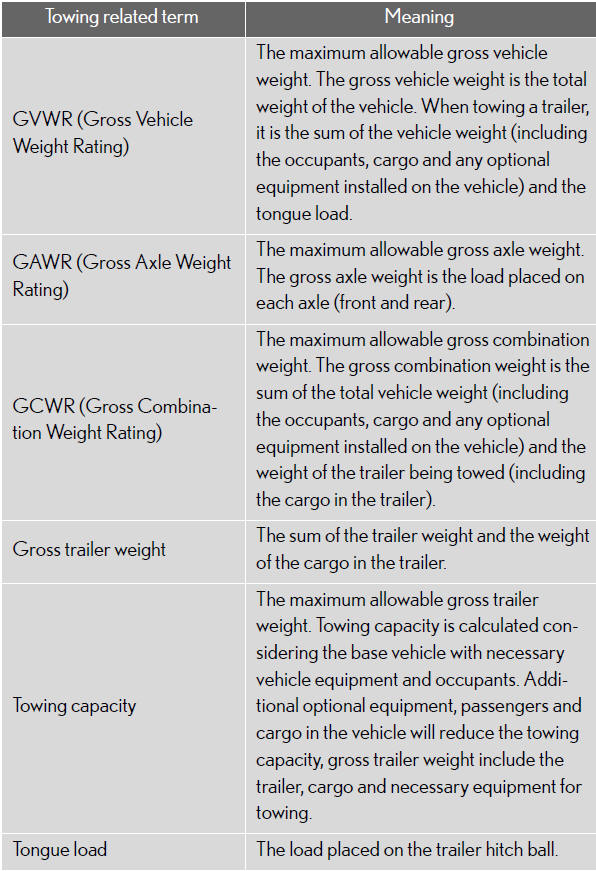
Trailer tongue load
A recommended tongue load varies in accordance with the types of trailers or towing as described below.
In order to ensure the recommended values shown below, the trailer must be loaded by referring to the following instructions.
The trailer cargo load should be distributed so that the tongue load is 9 to 11% of the gross trailer weight, not exceeding 350 lb. (158 kg).
(Tongue load / Gross trailer weight x 100 = 9 to 11%).
If the gross trailer weight is over 2000 lbs. (900 kg), it is necessary to use a sway control device with sufficient capacity.
The gross trailer weight and tongue load can be measured with platform scales found at a highway weighing station, building supply company, trucking company, junk yard, etc.
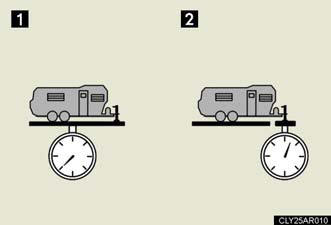
1. Gross trailer weight.
2. Tongue load.
Hitch and tow hitch receiver
Hitch
Trailer hitch assemblies have different weight capacities established by the hitch manufacturer. Even though the vehicle may be rated for towing a higher weight, the operator must never exceed the maximum weight rating specified for the trailer hitch.
Tow hitch receiver (if equipped)
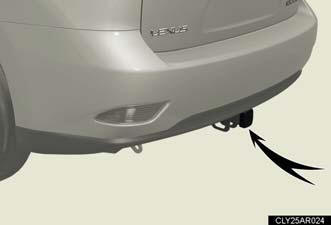
A tow hitch receiver installed under the rear bumper is rated for weight that does not exceed the vehicle's total towing weight.
Selecting a trailer ball
Use the correct trailer ball for your application.
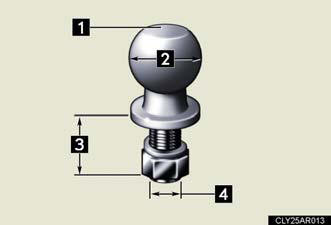
1. Trailer ball load rating.
Matches or exceeds the gross trailer weight rating of the trailer.
2. Ball diameter.
Matches the size of the trailer coupler.
Most couplers are stamped with the required trailer ball size.
3. Shank length.
Protrudes beyond the bottom of the lock washer and nut at least 2 threads.
4. Shank diameter.
Matches the ball mount hole diameter size.
Connecting trailer lights
Without towing package: Please consult your dealer when installing trailer lights, as incorrect installation may cause damage to the vehicle's lights. Please take care to comply with your state's laws when installing trailer lights.
With towing package: Use the 4 pin connector located under the rear bumper.
Auto current cut-off function (vehicles with towing package)
In case of over current, the auto cut-off function stops the power flowing to
the
trailer lights to prevent damage to the vehicle's electrical system.
This function is activated when the rated current of any of the following
trailer light
circuit components is exceeded:
Tail lights: maximum 7.8 A.
Stop/turn signal light (right): maximum 4.5 A.
Stop/turn signal light (left): maximum 4.5 A.
When the auto current cut-off function is activated
If a trailer light does not come on due to the activation of the auto current
cut-off
function, the light system will need to be reset.
Follow the reset procedure shown below.
If a tail light does not come on, turn off the headlight switch.
If the right-side stop/turn signal light does not come on, put the turn signal
in the
off position or remove foot from the brake pedal.
If the left-side stop/turn signal light does not come on, put the turn signal
in the
off position or remove foot from the brake pedal.
If the emergency flashers do not operate, press the emergency flasher switch to turn them off.
After the light system is reset, operate the light switches again to see if the
lights
operate normally.
If the lights do not operate normally, have the vehicle inspected by your Lexus dealer.
Trailer towing tips
Your vehicle will handle differently when towing a trailer. The 3 main causes of vehicle-trailer accidents are driver error, excessive speed and improper trailer loading. Keep the following in mind when towing: Before starting out, check the trailer lights and the vehicle-trailer connections.
Recheck after driving a short distance.
Practice turning, stopping and reversing with the trailer attached in an area away from traffic until you become accustomed to the feel of the vehicle.
Reversing with a trailer attached is difficult and requires practice. Grip the bottom of the steering wheel and move your hand to the left to move the trailer to the left. Move your hand to the right to move the trailer to right. (This is generally opposite to reversing without a trailer attached.) Avoid sharp or prolonged turning. Have someone guide you when reversing to reduce the risk of an accident.
As stopping distance is increased when towing a trailer, vehicle-tovehicle distance should be increased. For each 10 mph (16 km/h) of speed, allow at least one vehicle and trailer length.
Avoid sudden braking as you may skid, resulting in jackknifing and loss of control. This is especially true on wet or slippery surfaces.
Avoid jerky starts or sudden acceleration.
Avoid jerky steering and sharp turns, and slow down before making turns.
Note that when making a turn, the trailer wheels will be closer than the vehicle wheels to the inside of the turn. Compensate by making a larger than normal turning radius.
Crosswinds and rough roads will adversely affect handling of your vehicle and trailer, causing sway. Periodically check the rear to prepare for being passed by large trucks or buses, which may cause your vehicle and trailer to sway. If swaying occurs, firmly grip the steering wheel, reduce speed immediately but gradually, and steer straight ahead.
Never increase speed. If you make no extreme correction with the steering or brakes, your vehicle and trailer will stabilize.
Take care when passing other vehicles. Passing requires considerable distance. After passing a vehicle, do not forget the length of your trailer, and be sure you have plenty of room before changing lanes.
In order to maintain engine braking efficiency when driving on a long steep downgrade, do not use overdrive. Hybrid transmission shift range position must be in 4 in S mode.
Due to the added load of the trailer, your vehicle's hybrid system may overheat on hot days (at temperatures over 85°F [30°C]) when driving up a long or steep grade. If the engine coolant temperature gauge indicates overheating, immediately turn off the air conditioning (if in use), pull your vehicle off the road and stop in a safe spot.
Always place wheel blocks under both the vehicle and the trailer wheels when parking. Apply the parking brake firmly, and put the hybrid transmission in P. Avoid parking on a slope, but if unavoidable, do so only after performing the following: 1. Apply the brakes and keep them applied.
2. Have someone place wheel blocks under both the vehicle and trailer wheels.
3. When the wheel blocks are in place, release the brakes slowly until the blocks absorb the load.
4. Apply the parking brake firmly.
5. Shift into P and turn off the hybrid system.
When restarting after parking on a slope: 1. With the hybrid transmission in the P position, start the hybrid system.
Be sure to keep the brake pedal depressed.
2. Shift into 3, 2, 1, or the R position (if reversing).
3. Release the parking brake and brake pedal, and slowly pull or back away from the wheel blocks. Stop and apply the brakes.
4. Have someone retrieve the blocks.
When connecting and disconnecting a trailer (vehicles with electrically
modulated
air suspension)
Connecting.
1. Set the electronically modulated air suspension to LO mode.
2. Press the height control off button to turn off the electronically modulated air suspension.
3. Turn off the “POWER” switch.
4. Connect the trailer.
5. Turn on the “POWER” switch.
6. Press the height control off button again to turn on the electronically
modulated
air suspension.
7. Set the electronically modulated air suspension to N mode.
Disconnecting.
1. Set the electronically modulated air suspension to LO mode.
2. Press the height control off button to turn off the electronically modulated air suspension.
3. Turn off the “POWER” switch.
4. Set the supporting leg of the trailer on the ground and raise the hitch by 4
in. (100 mm)
5. Turn on the “POWER” switch.
6. Press the height control off button again to turn on the electronically
modulated
air suspension.
7. Wait until vehicle height is stabilized.
Make sure the hitch is disconnected. If the hitch does not disconnect, raise the
hitch
higher and repeat steps 2 through 7.
Before towing
Check that the following conditions are met: The vehicle's tires are properly inflated.
Trailer tires are inflated according to the trailer manufacturer's recommendation.
All trailer lights work.
All lights work each time you connect them.
The vehicle remains level when a loaded or unloaded trailer is hitched. Do not
drive if the vehicle is not level, and check for improper tongue load,
overloading,
worn suspension, or other possible causes.
The trailer cargo is securely loaded.
The rear view mirrors conform to all applicable federal, state/provincial or
local
regulations. If they do not, install rear view mirrors appropriate for towing
purposes.
Break-in schedule
If your vehicle is new or equipped with any new power train components (such
as
an engine, hybrid transmission, and wheel bearings), Lexus recommends that you
do not tow a trailer until it has been driven for over 500 miles (800 km).
However, avoid full throttle acceleration.
Maintenance
If you tow a trailer, your vehicle will require more frequent maintenance due
to
the additional load. (See “Warranty and Services Guide”, “Owner's Manual
Supplement”
or “Scheduled Maintenance”.)
Retighten the fixing bolts of the towing ball and bracket after approximately
600
miles (1000 km) of trailer towing.
CAUTION:
Trailer towing precautions
Follow all the instructions described in this section. Failure to do so could
cause
an accident resulting in death or serious injury.
Exceeding the towing capacity, GVWR or GAWR can cause an accident resulting in death or serious personal injuries.
To avoid accident or injury
Do not exceed the trailer hitch assembly weight, gross vehicle weight, gross
axle
weight and trailer tongue load capacities.
Never load more weight in the back than in the front of the trailer. About 60%
of
the load should be in the front half of the trailer, and the remaining 40% in
the
rear.
For vehicles with an electronically modulated air suspension, set the vehicle height to LO mode and turn off the electronically modulated air suspension to prevent the vehicle height from automatically changing.
The tow hitch receiver installed on your vehicle must never be used on another vehicle.
Do not exceed 45 mph (72 km/h) or the posted towing speed limit, whichever is
lower. As instability (swaying) of the towing vehicle-trailer combination
increases
as speed increases, exceeding 45 mph (72 km/h) may cause loss of control.
Slow down and downshift before descending steep or long downhill grades. Do not make sudden downshifts.
Avoid holding the brake pedal down too long or applying the brakes too frequently.
This could cause the brakes to overheat and result in reduced braking efficiency.
Do not tow the vehicle with the compact spare tire installed.
CAUTION:
Hitches
If you wish to install a trailer hitch, contact your Lexus dealer.
Use only a hitch that conforms to the gross trailer weight requirement.
Follow the directions supplied by the hitch manufacturer.
Lubricate the hitch ball with a light coat of grease.
Remove the trailer hitch whenever you are not towing a trailer. After removing
the hitch, seal any mounting hole in the vehicle body to prevent entry of any
substances
into the vehicle.
When towing a trailer
If the gross trailer weight exceeds 1000 lb. (450 kg), trailer brakes are
required.
Lexus recommends trailers with brakes that conform to all applicable federal and state/provincial regulations.
Never tap into your vehicle's hydraulic system, as this will lower the
vehicle's
braking effectiveness.
Never tow a trailer without using a safety chain securely attached to both the
trailer and the vehicle. If damage occurs to the coupling unit or hitch ball,
there is
danger of the trailer wandering into another lane.
NOTICE:
When installing a trailer hitch
Use only the position recommended by your Lexus dealer. Do not install the
trailer hitch on the bumper; this may cause body damage.
Do not use axle-mounted hitches, as they can cause damage to the axle housing, wheel bearings, wheels or tires.
Safety chain
A safety chain must always be used between the towing vehicle and the trailer.
Leave sufficient slack in the chain for turns. The chain should cross under the
trailer
tongue to prevent the tongue from dropping to the ground in the case that it
becomes damaged or separated. For the correct safety chain installation
procedure,
ask your Lexus dealer.
Do not directly splice trailer lights Directly splicing trailer lights may damage your vehicle's electrical system and cause a malfunction.
See also:
Cargo and luggage
Take notice of the following information about storage precautions, cargo
capacity and load.
l Stow cargo and luggage in the luggage compartment whenever
possible.
Be sure all items are secured in ...
Cargo
If getting to your destination isn't enjoyable, loading up the GX is even
more exasperating. To get to the cargo area, you have to open a huge swing gate.
While most SUVs have moved to a liftgate ...
Glove box
Glove box
1. Open (push button).
2. Lock with the mechanical key.
3. Unlock with the mechanical key.
Glove box light
The glove box light turns on when the tail lights are turned on.
Trunk open ...
